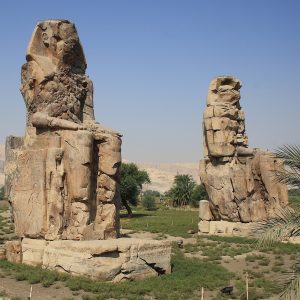The Colossi of Memnon facts reveal an incredible story about two massive statues that have stood for over 3,400 years in Luxor, Egypt.
The two massive stone statues of the Pharaoh Amenhotep III stand proudly on the West Bank of Luxor, Egypt, as silent guardians of a long-lost temple. Known as the Colossi of Memnon, these statues are over 3,400 years old and were originally part of a grand mortuary complex built for one of Egypt’s greatest pharaohs.
Despite centuries of earthquakes, floods, and looting, the Colossi of Memnon facts continue to intrigue historians, archaeologists, and travelers alike. From their mysterious “singing” sounds to their connection with Greek mythology, these statues remain one of the most fascinating ancient Egyptian monuments.
Colossi of Memnon Facts: Origins and Construction
The Colossi of Memnon facts date back to the 14th century BCE, during the reign of Pharaoh Amenhotep III. They were part of his mortuary temple complex, which was once the largest religious structure in Egypt, even bigger than Karnak Temple.
Construction Details
- Material: Quartzite sandstone transported from Gebel el-Ahmar, near modern Cairo.
- Height: 18 meters (59 feet) tall.
- Weight: Each statue weighs about 720 tons.
- Position: The statues depict Amenhotep III seated on a throne, facing the sunrise.
These engineering marvels were transported over 600 km (373 miles) from their quarry to Thebes, demonstrating the incredible skill of ancient Egyptian builders.

Colossi of Memnon Facts: Location and Accessibility
Where is the Colossi of Memnon Located?
- GPS Coordinates: 25.7343° N, 32.6104° E
- Distance from Luxor: About 4 km (2.5 miles) west of the Nile River.
- Nearby Landmarks:
- Valley of the Kings nearby sites, including the tomb of Tutankhamun.
- Temple of Hatshepsut – a beautifully preserved mortuary temple.
- Medinet Habu – a temple built by Ramses III.
The Colossi of Memnon facts make them one of the most visited tourist attractions in Luxor due to their historical importance and proximity to other famous sites.
Colossi of Memnon Facts: Symbolism and Purpose
The Colossi of Memnon facts reveal that these statues were more than just decorative monuments.
- Pharaoh’s Power: They depict Amenhotep III as a divine ruler, reinforcing his authority over Egypt.
- Guardian Statues: They served as protectors of his mortuary temple.
- Religious Significance: Ancient Egyptians believed the statues connected the pharaoh with the gods, ensuring his eternal rule in the afterlife.
Though the temple they once guarded is now gone, the Colossi of Memnon facts continue to symbolize the grandeur of ancient Egypt.
Colossi of Memnon Facts: The “Singing Statues” Mystery
One of the most famous Colossi of Memnon facts is the legend of the “singing statues.”
The Sound Phenomenon of Colossi of Memnon
- Ancient Greek and Roman travelers reported that the statues produced a mysterious sound at dawn.
- The sound was described as a musical hum or whistle, believed to be the voice of Memnon, a Trojan War hero.
- This made the statues a major tourist attraction in ancient times.
Scientific Explanation
- The sounds were likely caused by temperature changes that created vibrations in the stone due to cracks from an earthquake in 27 BCE.
- After repairs by Roman Emperor Septimius Severus in 199 CE, the sounds stopped, making it one of the greatest lost phenomena of the ancient world.
The Colossi of Memnon facts about this sound phenomenon remain one of the biggest unsolved mysteries in archaeology.
Colossi of Memnon Facts: Damage and Restoration
Despite their massive size, the Colossi of Memnon facts show that these statues have suffered significant damage over time.
Causes of Damage
- Earthquakes – The 27 BCE earthquake caused large cracks and structural damage.
- Flooding from the Nile – Water damage weakened the statues over centuries.
- Looting – Stone blocks were taken from the mortuary temple for other construction projects.
Restoration Efforts
- Roman Repairs (199 CE) – Septimius Severus ordered reconstruction, sealing the cracks that caused the “singing” effect.
- Modern Archaeology – Excavations in the 20th and 21st centuries uncovered more statues of Amenhotep III, proving the original temple’s grandeur.
- Ongoing Preservation – Conservation teams continue to prevent erosion and further deterioration.
The Colossi of Memnon facts show how restoration efforts have helped keep these statues standing as a reminder of ancient Egypt’s architectural genius.
Colossi of Memnon Facts: Visiting Information
For modern travelers, the Colossi of Memnon facts make them a must-visit site in Egypt.
Colossi of Memnon Ticket Price
- Entrance Fee: Free. The site is open to the public without a ticket.
Best Time to Visit
- Early Morning (6 AM – 9 AM) – Cooler temperatures, fewer crowds, and the best lighting for Colossi of Memnon photos.
- Sunset (4 PM – 6 PM) – Beautiful golden-hour photography.
How to Get There
- By Taxi – A 15-20 minute ride from Luxor costs about $5-$10.
- By Tour Bus – Most guided tours of Luxor’s West Bank include a stop at the Colossi.
- By Bicycle – A scenic option for budget travelers.
Colossi of Memnon Photos and Photography Tips
- Best angles are from the front of the statues, especially at sunrise or sunset.
- Tripods are allowed, but drones require special permission.
The Colossi of Memnon facts make them an ideal site for photographers looking to capture the beauty of ancient Egyptian monuments.
Colossi of Memnon Facts: Importance in Egyptian History
The Colossi of Memnon facts highlight their historical and cultural importance:
- They are among the oldest surviving statues from the New Kingdom.
- They were once part of one of the grandest temple complexes ever built.
- They were considered a “miracle” due to their mysterious “singing” phenomenon.
- They continue to attract thousands of tourists and scholars from around the world.
FAQS
Who Built the Colossi of Memnon?
The statues were commissioned by Pharaoh Amenhotep III, the ninth ruler of the 18th Dynasty, and built by skilled Egyptian artisans. The construction was part of a massive temple complex meant to honor his reign and legacy.
How Old Are the Colossi of Memnon?
The statues are over 3,400 years old, dating back to around 1350 BCE.
What Are the Features of Colossi of Memnon?
- Height: 18 meters (59 feet)
- Weight: 720 tons each
- Material: Quartzite sandstone
- Depiction: Amenhotep III seated, hands resting on knees, with smaller figures of his mother and wife beside him.
How Many Colossi Are There?
There are two massive stone statues of the Pharaoh Amenhotep III, positioned at the entrance of his former mortuary temple.
How Did the Colossi of Memnon Sing?
Ancient travelers, including the Greek historian Strabo, reported that the statues produced a musical sound at dawn. This was believed to be the voice of Memnon, a hero from Greek mythology.
What is the Secret of Memnon?
The sound was likely caused by temperature changes creating vibrations in the cracked stone. After repairs in 199 CE, the sound stopped, making it one of history’s lost mysteries.
What Damaged the Colossi of Memnon?
The statues suffered significant damage due to:
- An earthquake in 27 BCE that caused large cracks.
- Nile flooding over centuries, leading to erosion.
- Looting, with stone blocks taken for later construction.
Restoration Efforts
- Roman Emperor Septimius Severus (199 CE) repaired the cracks, stopping the “singing” effect.
- Modern archaeologists continue to work on preservation efforts.
What Does the Colossi of Memnon Represent?
The statues symbolize Pharaoh Amenhotep III’s power, serving as guardians of his mortuary temple and reinforcing his divine connection with the gods.
What is the Colossi of Memnon in Arabic?
In Arabic, the statues are known as “el-Colossat” or “Salamat”, meaning “the statues of peace.”
Who Was Memnon?
Memnon was a mythological Ethiopian king and a hero in Greek mythology, said to be the son of Eos (the goddess of dawn) and Tithonus.
Was Memnon a Real Person?
No, Memnon was a legendary warrior mentioned in Homer’s Iliad, who fought in the Trojan War.
Who Did Memnon Fight For?
Memnon fought for Troy against the Greeks during the Trojan War.
Was Memnon a Demigod?
Yes, in mythology, Memnon was considered a demigod, being the son of a mortal and a goddess (Eos).
How Strong Was Memnon?
According to Greek myths, Memnon was a warrior as powerful as Achilles, but he was ultimately defeated and killed by Achilles in battle.
Was Memnon Greek or Persian?
Memnon was neither Greek nor Persian—he was described as the King of Ethiopia, a powerful kingdom in Africa.
What Race Was Memnon?
In Greek mythology, Memnon was described as an African warrior, and some accounts depict him as a Nubian or Ethiopian king.
Is Memnon Related to Agamemnon?
No, despite the similarity in their names, Memnon and Agamemnon (the Greek king) were not related.
What is the Memnon Theory?
The Memnon Theory suggests that ancient travelers associated the singing Colossi with the mythical Memnon due to the sound phenomenon occurring at dawn—aligning with Memnon’s legendary connection to the goddess Eos (dawn).
What Happened to Memnon?
According to legend, after his death, Memnon’s mother, Eos, begged Zeus to grant her son immortality, and he was transformed into a constellation.
Is Achilles Greek or Egyptian?
Achilles was Greek, specifically a hero of the Myrmidons of Thessaly, as described in Homer’s Iliad.
Is Memnon Related to Achilles?
No, Memnon and Achilles were not related, but they were rivals in the Trojan War. Memnon was said to be one of the few warriors who could challenge Achilles before being slain by him.
Conclusion
The Colossi of Memnon facts provide a glimpse into the engineering, mythology, and grandeur of ancient Egyptian civilization.
From their massive size and mystical “singing” legend to their enduring presence in Luxor, the Colossi of Memnon facts continue to fascinate and inspire visitors worldwide.
For anyone visiting Egypt, the Colossi of Memnon facts make them a must-see attraction that reflects the genius and mystery of the pharaohs.


0 Comment